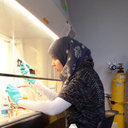Chemical compositions and biological activities of Amomum subulatum essential oils from Nepal.
Avainsanat
Abstrakti
The essential oils from the seed and rind of Amomum subulatum Roxb. (collected from Nepal) were obtained by hydrodistillation and analyzed by GC-MS. A total of 87 components were identified among the two essential oils accounting for 99.1%, and 99.0% of the oils, respectively. The two essential oils were dominated by the monoterpenoids 1,8-cineole (60.8% and 39.0%), alpha-pinene (6.4% and 4.8%), beta-pinene (8.3% and 17.7%), and alpha-terpineol (9.8% and 12.3%). Allelopathic testing of the seed essential oil showed an inhibition of seed germination of Lactuca sativa and Lolium perenne, with IC50 values of 1583 and 1674 microg/mL, respectively. The seed essential oil demonstrated a stronger seedling growth inhibition of L. perenne than of L. sativa. A. subulatum seed and rind oils also showed moderate brine shrimp lethality (LC50 = 28.1 +/- 3.0 and 15.0 +/- 9.0 microg/mL, respectively). The seed and rind oils were only marginally cytotoxic (20% and 30%% kill on MCF-7 cells at 100 microg/mL, respectively), and antibacterial (MIC > or = 313 microg/mL), but A. subulatum rind oil was appreciably active against the fungus Aspergillus niger (MIC = 19.5 microg/mL). The essential oils of A. subulatum were also screened for nematocidal activity against Caenorhabditis elegans and insecticidal activity against the fruit fly (Drosophila melanogaster) and the red imported fire ant (Solenopsis invicta x richteri). The seed oil was only marginally toxic to the fire ant (LC50 = 1500 microg/mL), but moderately toxic to the nematode and the fruit fly (LC50 = 341 and 441 microg/mL, respectively).




